5 - Splits and unrooted phylogenetic networks
from Part II - Theory
Published online by Cambridge University Press: 05 August 2011
Summary
The concept of a split plays an important role in the mathematics of phylogeny. It is motivated by the simple, but crucial, observation that every edge e in an unrooted phylogenetic tree T defines a bipartition of the underlying taxon set X into two non-empty and disjoint subsets, A and B, known as a split. The splits of an unrooted phylogenetic tree uniquely define the topology of the tree and splits are used, for example, to compare different trees or to compute consensus trees. Any set of splits that is compatible corresponds to a phylogenetic tree and so one possible way to generalize from trees to networks is to consider sets of splits that are incompatible.
Splits provide the basis of unrooted phylogenetic trees and a large class of unrooted phylogenetic networks, namely split networks, just as clusters provide the basic building blocks for rooted phylogenetic trees and networks (see Chapter 6). The foundation for the theory of split networks was laid down in a seminal paper by Bandelt and Dress [9].
Overview
Figure 5.1 shows the relationships between some of the main concepts introduced in this chapter. The focus is on splits, and on split networks as an important type of unrooted phylogenetic networks. We compare splits to clusters, since the two concepts are closely related to each other. We describe the Buneman graph construction that provides a canonical split network for an arbitrary set of splits. We shall see that splits can be compatible, circular or weakly compatible.
- Type
- Chapter
- Information
- Phylogenetic NetworksConcepts, Algorithms and Applications, pp. 87 - 126Publisher: Cambridge University PressPrint publication year: 2010



